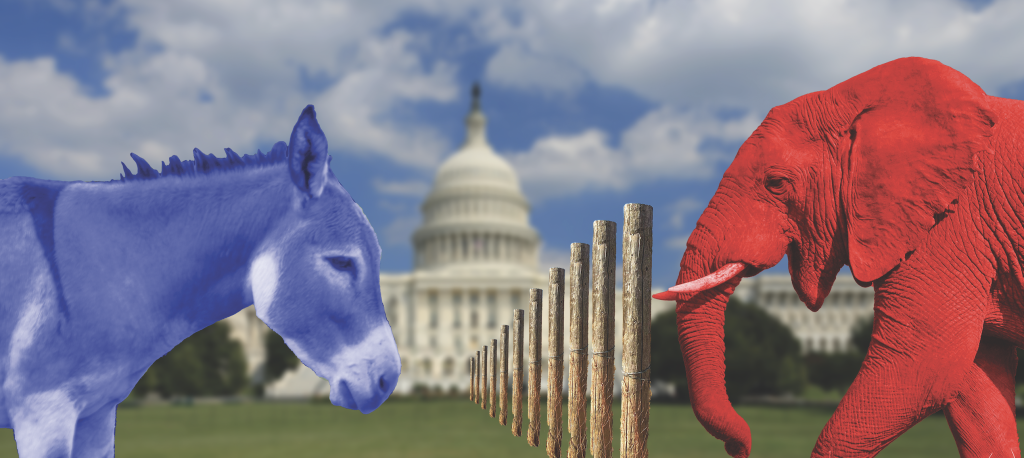After 9/11, Americans identified Al-Qaeda as their greatest common enemy, taking the place of the Soviet Union, which had collapsed 10 years prior. As a result of this tragedy and the identification of an external enemy that it incited, a strong sense of unity was established among Americans for a time. Once that feeling of communal coherency wore off, however, the everyday differences in beliefs and practices between Americans manifested themselves just as before.
The identification and recognition of a common enemy is one of the greatest tools to create unity among a diverse group of people, just as the American reaction to 9/11 proved. Psychology Today notes the importance of common enemies, saying “enemies give us a sense of control, allowing us to attribute bad things to a clear cause that can be understood, contained and controlled.”
In 2024, there are few ways of identifying and categorizing people more divisively than by political affiliation. By labeling a person “Democrat” or “Republican,” a large portion of the population will disassociate or find someone unfavorable simply because they are of the “opposite” philosophy.
“Ideological overlap between the two parties has diminished,” according to the Pew Research Center, and with it, the ability to see fellow Americans as friends. Because the U.S. almost exclusively functions under Democrat or Republican regimes, it is easier for many to scope out an enemy in the form of a blue donkey or a red elephant instead of thinking critically about matters.
In fact, the Pew Research Center found that 43% of Republicans express a highly unfavorable view of Democrats and 38% of Democrats express a similar view of Republicans. This division is only worsening, as the belief that the opposing party is a threat to the union doubled in a 20-year period from 1994 to 2014, according to a Pew Research Center poll.
So as American politics become ever more polarized between the left and the right, the question must be raised: Why are Americans confining themselves to a two-party system which has shown itself to be highly divisive? A simple answer is people need someone to blame for their problems, and looking across the political aisle is the most straightforward and enticing way to do so.
If a third, fourth or even fifth party became a viable option in the U.S., Americans would have a more difficult time assigning blame to a single source. This would confuse the populace and make politics far more complicated, but that is a small price to pay for a less divisive political climate. For instance, a soccer match is played between two teams. Team one knows it cannot let team two score a goal and vice versa because they are opponents. If more teams are introduced, it would become far less clear who the opponent is and therefore, less obvious as to who must be defeated.
A climate such as the one described would benefit the U.S. greatly, as it would provoke Americans to attribute their issues to external forces rather than to fellow Americans who simply check different boxes at the polls. America, in its purest form, is a culture of former misfits and refugees which have come together to form a nationalistic melting pot. And if, in a culture such as this, political division manifests itself as hatred for one’s neighbor, then the American idea is failing. John Adams predicted this downfall, saying, “There is nothing which I dread so much as a division of the republic into two great parties.”
However optimistic the thought of the two-party system making way for additional parties may be, it would prove extremely difficult for the current system to be amended. The Hill notes that “this disgust for the status quo is why voters in both parties are flocking to ‘outsider’ candidates,” though the “outsiders” who do not identify as Democrat or Republican routinely fail in major elections, according to Al Jazeera. Wall Street columnist, Bill Galston, stated that there is “really almost no room for a third party,” when speaking about politics in the U.S.
For those who desire change from this two-party system that is destined to continually stall unity and distract from real issues, there are methods by which a change can come. The Denver Post declares that 42% of state lawmaker elections were run with very little opposition. In 2022, Ballotpedia noted that 59% of Massachusetts state races were won unopposed. This means that there is ample opportunity for third-party candidates to participate in state and local elections and provide a refreshing alternative to two-party stagnation.
Still, the barriers in place that prevent the dissolvement of the two-party system are strong. The electoral college and common American tradition are unfriendly to divergent methods of election and popular party-alignment, and rightly so, as they have produced one of the freest nations to ever exist. But the unignorable political polarization that is growing ever more potent is not a sour byproduct of the sweetness of freedom. It is the result of a divisive system that must be amended.
Kilker is the opinion editor for the Liberty Champion
